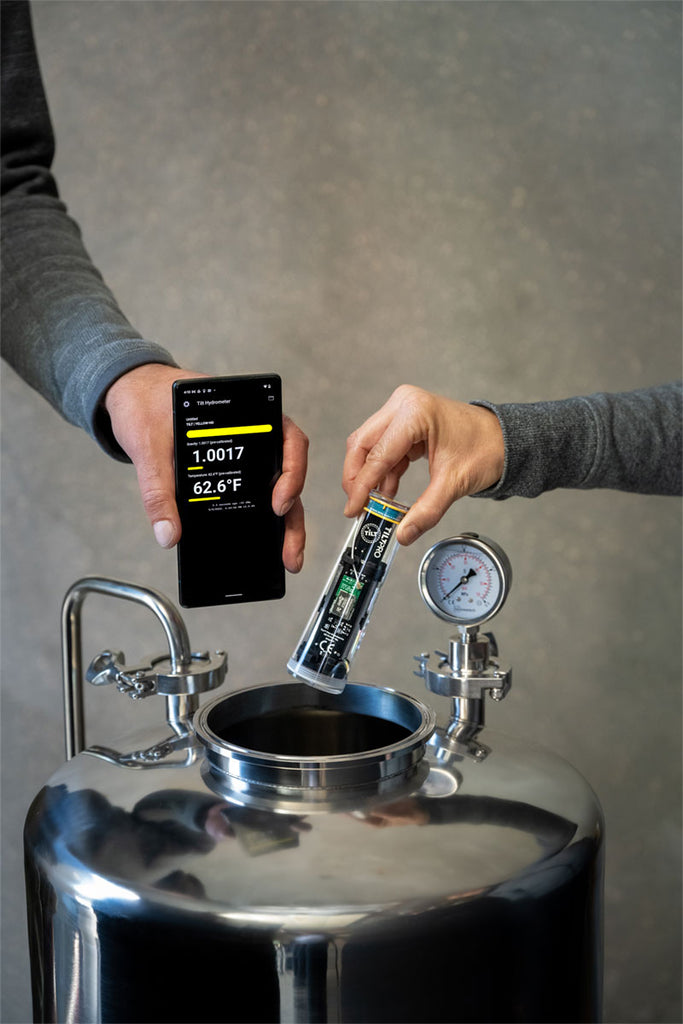Using the Tilt Hydrometer to Track Fermentation: A Meadmaker’s Perspective

Fermentation is a slow and sometimes unpredictable process. Whether you’re making mead, beer, cider, or any other fermented beverage, keeping track of gravity changes is crucial for knowing when fermentation is slowing down, when it’s done, and how your yeast is performing. Enter the Tilt Hydrometer—a wireless, floating digital hydrometer that makes monitoring fermentation easy, precise, and, most importantly, hands-free.
Why Use a Tilt Hydrometer?
The Tilt Hydrometer is a game-changer for homebrewers, especially those who are tired of pulling samples with a thief, checking gravity with a hydrometer or refractometer, and worrying about contamination every time they open their fermenter. For me, trying to get an accurate reading from a traditional hydrometer is difficult, the gradations can be hard to read properly due to small text, the liquid “bubble” obscuring the exact reading, etc. Instead, the Tilt sits inside the fermenter, continuously sending gravity and temperature readings via Bluetooth to your phone, tablet, or a Raspberry Pi running Tilt Pi.
For meadmakers, precision is key. Mead fermentation can take weeks or even months, and a sudden stall or spike in temperature can drastically impact the final product. With the Tilt, you can monitor your fermentation without disturbing your batch, allowing for smoother and more predictable results.
Setting Up and Using the Tilt Hydrometer
Getting started with the Tilt is surprisingly simple:
1. Calibrating Your Tilt
Before dropping it into a batch, it’s a good idea to calibrate your Tilt. This is done by:
- Placing the hydrometer in distilled water at 60°F (15.5°C) (or whatever your calibration temp is).
- Checking that it reads 1.000 SG.
- Adjusting offsets in the Tilt app if necessary.
2. Sanitizing and Dropping It In
Like any brewing equipment, sanitization is crucial. The Tilt is waterproof and can be sanitized like any other brewing tool—just soak it in Star San or your preferred no-rinse sanitizer. Once sanitized, simply drop it into your fermenter.
3. Reading Gravity and Temperature
The Tilt transmits real-time readings to your phone, tablet, or Raspberry Pi via Bluetooth. The Tilt app allows you to:
- Track gravity readings over time.
- Log temperature fluctuations.
- Send data to Google Sheets for long-term tracking.
- Get push notifications when fermentation slows or temperatures deviate from your set range.
For meadmakers working with slow, steady fermentations, this data is invaluable. You can see if your yeast needs a nutrient boost, if it’s struggling due to temperature, or if something is off before problems arise.
Using Tilt Pi for Automated Fermentation Tracking
If you don’t want to rely on keeping your phone near your fermenter at all times, Tilt Pi is a perfect companion. This software, designed to run on a Raspberry Pi, acts as a dedicated Tilt data logger, automatically collecting readings and storing them for long-term tracking.
Setting Up Tilt Pi
- Get a Raspberry Pi – Any model with Bluetooth will work, but the Raspberry Pi 3 or 4 is ideal.
- Download the Tilt Pi SD Card Image – The latest version is available here.
- Flash the SD Card – Use Raspberry Pi Imager or balenaEtcher to write the Tilt Pi image to an SD card.
- Boot the Pi – Insert the SD card, power up the Raspberry Pi, and connect it to your network.
- Access the Tilt Pi Web Interface – From any device on the same network, access the Tilt Pi dashboard to view live fermentation data.
Why Use Tilt Pi?
- Automated Logging – No need to keep a phone near the fermenter.
- Google Sheets Integration – Tracks long-term fermentation trends.
- Remote Monitoring – View data from anywhere on your network.
- Multi-Tilt Support – Useful if you have multiple fermentations going at once.
For serious meadmakers and brewers, Tilt Pi ensures you’re always collecting data without any extra effort.
Beyond Mead: Using Tilt for Other Fermentations
While I primarily use my Tilt for mead, it’s just as useful for:
- Beer Brewing – Especially for tracking high-flocculating yeast strains that might stall fermentation early.
- Cider Making – Helps monitor wild fermentations where temperature swings can impact the final profile.
- Kombucha – Less common but useful for tracking sugar consumption in primary fermentation.
- Experimental Brews – If you’re fermenting fruit wines, sours, or mixed-culture ferments, Tilt gives valuable insight into how your yeasts and bacteria are working.
The ability to track trends over time means fewer surprises when it’s time to bottle or keg.
Alternatives to the Tilt Hydrometer
While the Tilt is a fantastic tool, it’s not the only digital hydrometer on the market. Here are some alternatives that might be worth considering:
-
- Measures CO₂ release to estimate fermentation progress.
- Completely non-intrusive (doesn’t sit in the liquid).
- Good for brewers who want fermentation data without opening the fermenter.
-
- Open-source DIY alternative to the Tilt.
- Requires some assembly and calibration.
- Supports Wi-Fi for continuous monitoring.
-
- Wi-Fi-enabled floating hydrometer.
- Stores data in the cloud with a web-based dashboard.
- Good for those who prefer Wi-Fi over Bluetooth.
-
- Another DIY-style smart hydrometer.
- Fully configurable with Wi-Fi logging.
- Ideal for tinkerers who want control over data collection.
Final Thoughts
The Tilt Hydrometer takes the guesswork out of fermentation, allowing meadmakers, brewers, and fermenters of all kinds to track gravity changes without lifting a finger. When paired with Tilt Pi, it becomes even more powerful, creating a hands-off fermentation logging system that ensures better control over your brew.
For anyone looking to upgrade their fermentation tracking, the Tilt is a worthy investment—but if you’re more of a DIYer or want different tracking methods, the alternatives listed above might be a better fit.
Either way, ditching manual hydrometer readings for automated tracking makes the brewing process smoother, more efficient, and ultimately more enjoyable.
